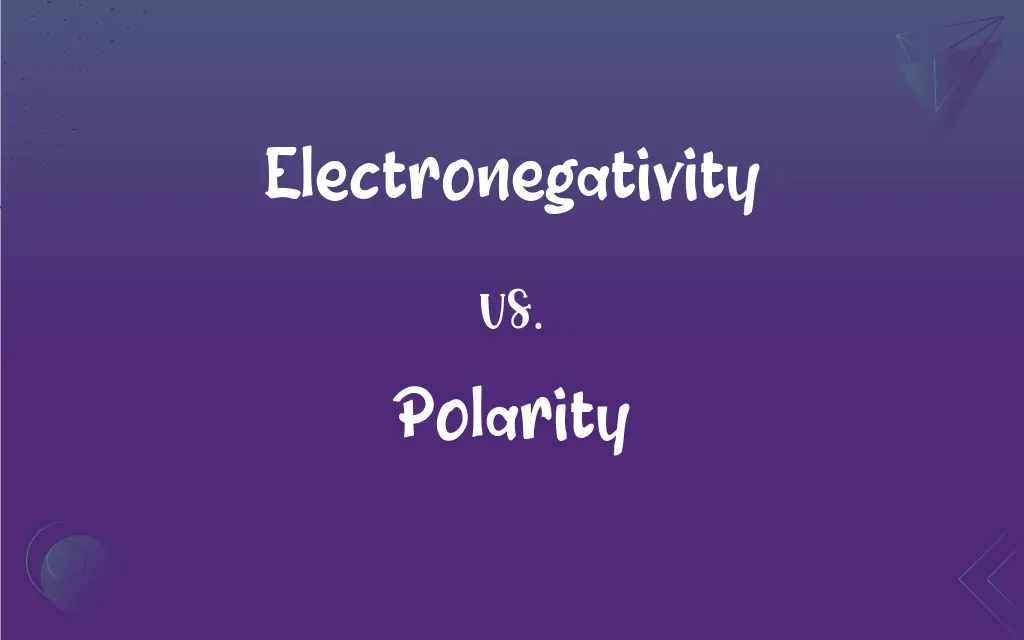Electronegativity vs. Polarity: What's the Difference?
By Janet White || Published on December 2, 2023
Electronegativity is an atom's ability to attract electrons, while polarity refers to the distribution of electric charge across a molecule.

Key Differences
Electronegativity is a chemical property that describes how strongly an atom can attract or hold onto electrons. In contrast, polarity is a broader concept that refers to the distribution of electric charges in a molecule, determined by the arrangement of atoms and the electronegativity of each atom.
While electronegativity is specific to individual atoms, polarity is a property of molecules. Electronegativity influences polarity, as differences in electronegativity between atoms in a molecule can lead to unequal sharing of electrons, creating polar molecules.
Electronegativity is quantified on various scales, such as the Pauling scale, and is specific to each element. Polarity, however, is not quantified in the same way; it is a qualitative description of a molecule’s charge distribution, influenced by the relative electronegativities of its constituent atoms.
In the context of chemical bonding, electronegativity helps predict bond types (ionic, covalent, or polar covalent), whereas polarity is essential in determining a molecule's physical properties, like solubility and boiling point.
Electronegativity is a concept used primarily in atomic and molecular chemistry. Polarity, however, has a wider application, extending to fields like physical chemistry and materials science, where it explains molecular interactions and behaviors.
ADVERTISEMENT
Comparison Chart
Definition
Atom's ability to attract electrons
Distribution of electric charge
Scope
Pertains to individual atoms
Pertains to molecules
Influence on Bonding
Determines bond type
Influences molecular interactions
Quantification
Measured on scales like Pauling scale
Qualitative; not measured precisely
Role in Physical Properties
Influences bond polarity
Determines solubility, boiling point
ADVERTISEMENT
Electronegativity and Polarity Definitions
Electronegativity
Electronegativity is the measure of an atom's ability to attract and hold electrons.
In a water molecule, oxygen's higher electronegativity pulls electrons closer, creating a polar bond.
Polarity
Polarity is the characteristic of molecules having an uneven charge distribution.
The polarity of a molecule like HCl dictates its acidic behavior.
Electronegativity
Electronegativity reflects how strongly atoms compete for electrons in a bond.
Chlorine's high electronegativity makes it effective in forming ionic bonds.
Polarity
Polarity arises from differences in electronegativity between bonded atoms.
Ammonia's polarity affects its boiling point and solubility.
Electronegativity
Electronegativity is an intrinsic property of atoms affecting bond formation.
The electronegativity difference between hydrogen and oxygen leads to the formation of polar water molecules.
Polarity
Polarity influences the physical and chemical properties of substances.
The polarity of ethanol makes it miscible with water.
Electronegativity
Electronegativity dictates the electron density around an atom in a molecule.
Carbon's moderate electronegativity allows for versatile bonding in organic compounds.
Polarity
Polarity refers to the distribution of electrical charge over atoms forming a molecule.
Water's polarity allows it to dissolve various ionic compounds.
Electronegativity
Electronegativity is a predictor of an element's chemical reactivity.
Fluorine's high electronegativity makes it highly reactive.
Polarity
Polarity determines the dipole moment of a molecule.
The polarity in carbon dioxide is zero due to its linear structure, despite having polar bonds.
Electronegativity
(chemistry) The tendency, or a measure of the ability, of an atom or molecule to attract electrons when forming bonds.
Polarity
Intrinsic polar separation, alignment, or orientation, especially of a physical property
Magnetic polarity.
Ionic polarity.
Electronegativity
(chemistry) the tendency of an atom or radical to attract electrons in the formation of an ionic bond
Polarity
An indicated polar extreme
An electric terminal with positive polarity.
FAQs
Does polarity affect a molecule's solubility?
Yes, polarity significantly influences a molecule's solubility in various solvents.
What is electronegativity?
Electronegativity is an atom's tendency to attract and hold onto electrons.
How is polarity related to molecular structure?
Polarity is determined by the distribution of electric charge, influenced by the molecule's structure and the atoms' electronegativities.
Are nonpolar molecules affected by electronegativity differences?
Nonpolar molecules have little to no electronegativity difference between bonded atoms.
How does polarity influence intermolecular forces?
Polarity affects intermolecular forces like hydrogen bonding, dipole-dipole, and London dispersion forces.
Does the shape of a molecule affect its polarity?
Yes, molecular shape can influence charge distribution, thus affecting polarity.
Is electronegativity considered in predicting reaction outcomes?
Electronegativity is crucial in predicting how atoms will interact and bond in reactions.
Are polar molecules always soluble in water?
Polar molecules are often water-soluble, but this is not a universal rule.
Can electronegativity be directly measured?
Electronegativity is not measured directly but is calculated based on other atomic properties.
What role does electronegativity play in bond formation?
Electronegativity helps determine whether a bond will be ionic, covalent, or polar covalent.
Is electronegativity constant across all compounds?
Electronegativity is a constant for each element but can vary slightly in different chemical environments.
How does electronegativity impact acid strength?
Higher electronegativity often correlates with stronger acid strength due to easier proton donation.
Can polarity influence a substance's boiling point?
Yes, polarity can affect a substance's boiling and melting points.
Is the concept of electronegativity applicable to all elements?
Electronegativity is applicable to most elements, especially nonmetals.
How does electronegativity affect molecular dipoles?
Differences in electronegativity between atoms create molecular dipoles in polar compounds.
How does molecular geometry affect polarity?
Molecular geometry can cause polar bonds to cancel out, leading to nonpolar molecules.
Is it possible for an atom to have zero electronegativity?
In theory, no. All atoms have some degree of electronegativity, though it can be very low.
Can polarity determine a molecule’s reactivity?
Yes, polarity can influence how a molecule interacts and reacts with other substances.
Are metals typically high in electronegativity?
Metals generally have lower electronegativities compared to nonmetals.
Can electronegativity indicate the type of chemical bond?
Yes, electronegativity differences can indicate whether a bond is ionic, covalent, or polar covalent.
About Author
Written by
Janet WhiteJanet White has been an esteemed writer and blogger for Difference Wiki. Holding a Master's degree in Science and Medical Journalism from the prestigious Boston University, she has consistently demonstrated her expertise and passion for her field. When she's not immersed in her work, Janet relishes her time exercising, delving into a good book, and cherishing moments with friends and family.






































































